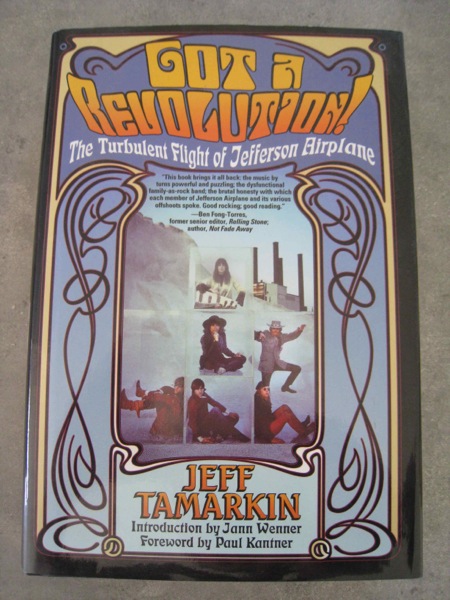Jeff Tamarkin Got A Revolution! - The Turbulent Flight Of Jefferson Airplane

Faced with a couple of Rear Views over on the Music Pages that involved bands that emerged in San Francisco in and around the Summer of Love I needed a read that’d take me back to that era and on the bookshelves there were two obvious candidates - this volume and Dennis McNally’s A Long Strange Trip.
Given the fact that the three bands I was looking at over there failed to develop into anything that resembled an on-going cultural phenomenon, I opted for an examination of the Turbulent Flight option rather than the Long Strange Trip, figuring that it was better to examine something that seemed to offer a lot then failed to deliver rather than something that started in a particular place and time and, like Topsy, more or less just grew.
Of the big names that came out of San Francisco in 1967, Jefferson Airplane seemed to offer the most long-term potential.
Anyone in my neighbourhood who heard the first Grateful Dead album was probably left scratching their heads and wondering what the fuss was about.
If you took Janis Joplin away from Big Brother & The Holding Company (and, of course, they eventually did) there wasn’t much left, and after two pretty good albums Country Joe & the Fish seemed to be running out of steam and ideas. Quicksilver Messenger Service, the Steve Miller Band and Mother Earth never went near the stratosphere, and that was, it seemed, more or less that.
Contrast those failures to deliver with the Airplane’s apparent run of success. After Somebody To Love and White Rabbit, the albums Surrealistic Pillow, After Bathing At Baxter’s and Crown Of Creation seemed to be substantial statements by a band that was definitely heading somewhere.
From there, however, it wasn’t long till the wheels fell off and things fell back to Earth with a reasonably resounding thud. The ins and outs (using that term deliberately) of the inter-personal relations within the Airplane were no secret at the time, and, looking back on things it’s hardly surprising that the conveyance more or less imploded.
Tamarkin documents the strange case of Jefferson Airplane with all its twists, turns, knives in the back, spats and reconciliations clearly. It’s easy, forty years on, to forget how strong the Airplane’s classic line-up was - four separate voices who could take the lead vocal, four writers, and a guitar/bass combination that was one of the best of all time.
The drummer wasn’t too shabby either.
In many ways it was an embarrassment of riches. Looking back, it’s hard to see how you’d have expected this sort of multi-headed hydra to survive, particularly when every one of the major figures had quite definite opinions about their world and the direction in which it ought to be heading.
And that’s without taking the political and cultural influences at play in the world around them into account. The publicity surrounding the Summer of Love, the issues involving the Vietnam War and the draft, widespread drug usage and authorities at all levels looking to stamp out any form of deviant behaviour made for what were always going to be interesting times.
As a recreation of those times, Got A Revolution! offers a thorough account of how the individual members ended up inside the Airplane, what happened while they were there and what happened afterwards.
Jeff Tamarkin’s familiarity with the group’s history and discography coupled with meticulous research work, extensive interviews and direct access to the members of the band, make Got A Revolution! indispensable for both long term fans and readers with a casual interest in the life and times of one of the most significant bands to come out of the 1960s.
Not that Tamarkin confines himself to the band’s heyday. He tells the whole story from the band’s emergence through its reincarnation as the Jefferson Starship in the seventies, past the Reagan/MTV era of the eighties and into the various reunions and realignments that have continued into this century.
There’s an epilogue which brings readers up-to-date, a list of internet resources, an eight page discography that would have been much more substantial if Tamarkin had included album track-listings (and, at eight pages it’s obvious why he didn’t) and a bibliography that’s about the same length.
Essential reading for anyone with an interest in the history of rock music.

